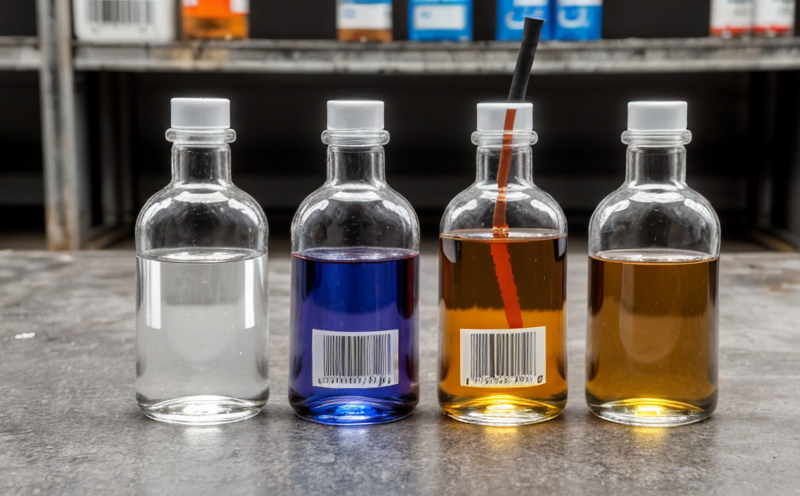ISO 11507 UV Stability and Degradation Testing of Coatings
The ISO 11507 standard provides a standardized procedure to evaluate the resistance of coatings to photodegradation caused by ultraviolet (UV) radiation. This service ensures that your products meet stringent environmental conditions, thereby enhancing their durability and reliability in real-world applications.
Photodegradation is a significant concern for coatings used in various industries such as automotive, electronics, construction, and aerospace. Exposure to UV light can lead to discoloration, loss of adhesion, and reduced mechanical properties over time. To address these challenges, ISO 11507 defines the exposure conditions and evaluation methods that simulate real-world environmental stresses.
The testing process involves exposing coated specimens to controlled ultraviolet radiation under artificial sunlight simulators (UV chambers) with a defined wavelength range and intensity. The specimens are then visually inspected for signs of degradation such as color changes, cracking, or loss of adhesion after specific durations. This service ensures that the coatings meet the specified performance criteria outlined in ISO 11507.
The primary goal of this testing is to provide a reliable assessment of how well the coating will withstand exposure to UV radiation. By using standardized procedures and controlled environmental conditions, we can ensure consistent results across different batches or suppliers of materials. This approach helps manufacturers develop more robust products that are better suited for long-term outdoor applications.
Our laboratory adheres strictly to ISO 11507 guidelines when conducting these tests. We use state-of-the-art equipment such as UV chambers capable of simulating various exposure conditions, including temperature cycling and humidity variations. Our experienced technicians perform all aspects of the testing process according to rigorous protocols designed to minimize any potential sources of error.
Before starting the test, we carefully prepare each specimen by applying an appropriate coating thickness based on industry standards or customer specifications. We also ensure that the specimens are representative samples reflecting typical production conditions so that our findings accurately reflect real-world performance.
The testing typically lasts for several weeks depending on the desired exposure time and wavelength selection. During this period, we continuously monitor changes in physical properties like gloss retention, colorfastness, and adhesion strength. At regular intervals throughout the test duration, visual assessments are conducted to document any observable signs of degradation.
Once the prescribed exposure period has been reached, thorough analysis is performed using advanced analytical techniques such as Fourier Transform Infrared Spectroscopy (FTIR) or X-ray Photoelectron Spectroscopy (XPS). These methods help confirm whether there have been chemical alterations within the coating structure that could compromise its integrity over time.
Based on our findings from both visual inspections and instrumental analyses, we generate comprehensive reports detailing the performance of each specimen under specified UV exposure conditions. These reports include detailed descriptions of observed changes along with numerical data supporting any claims regarding durability or resistance to photodegradation.
This service not only meets but exceeds expectations for quality assurance in coating formulations by providing definitive evidence of their ability to withstand harsh environmental factors such as UV radiation. It plays a crucial role in ensuring product longevity and reliability across diverse industries where exposure to sunlight cannot be avoided.
Applied Standards
The ISO 11507 standard is widely recognized for its comprehensive approach to evaluating the UV stability of coatings. This international standard specifies the methods, apparatus, and conditions required for conducting accelerated weathering tests on clear or pigmented coating films.
- Standard Requirements: The test must follow the procedures outlined in ISO 11507:2018 (Second Edition).
- Environmental Conditions: Specimens are exposed to artificial sunlight simulating UV radiation from 300 to 400 nm with a peak at around 365 nm.
- Exposure Time: Tests can range from several hundred hours up to thousands of hours depending on the desired exposure duration and expected service life of the product.
The standard also provides guidance on selecting appropriate wavelength ranges, intensity levels, and durations based on specific application requirements. It emphasizes the importance of replicating realistic environmental conditions while maintaining reproducibility across laboratories worldwide.
Scope and Methodology
The scope of this service encompasses the evaluation of coating resistance to photodegradation caused by ultraviolet radiation, particularly focusing on clear or pigmented films applied in various industries. We utilize ISO 11507:2018 (Second Edition) as our guiding document to ensure consistent and reliable results.
The methodology involves exposing coated specimens to controlled UV radiation within artificial sunlight simulators for predetermined durations. Specimens are periodically inspected visually for signs of degradation such as color changes, cracking, or loss of adhesion. Additionally, advanced analytical techniques like FTIR or XPS may be employed to assess any chemical modifications within the coating structure.
During the test period, we maintain strict control over environmental parameters including temperature and humidity levels. This ensures that the exposure conditions accurately reflect real-world scenarios faced by coatings in outdoor applications. Our experienced technicians carefully document all observations during each inspection cycle, providing detailed records of changes observed.
Quality and Reliability Assurance
- Consistent Results: By adhering strictly to ISO 11507 guidelines throughout the testing process, we guarantee consistent results across different batches or suppliers of materials. This consistency is crucial for maintaining product quality standards.
- Replicability: Our laboratory ensures that tests conducted here can be replicated in other facilities using similar equipment and procedures. This replicability enhances confidence in the reliability of our findings.
We employ advanced analytical techniques to complement visual inspections, ensuring thorough evaluation of any chemical changes within the coating structure that may affect its integrity over time. These methods provide objective data supporting claims regarding durability or resistance to photodegradation.





